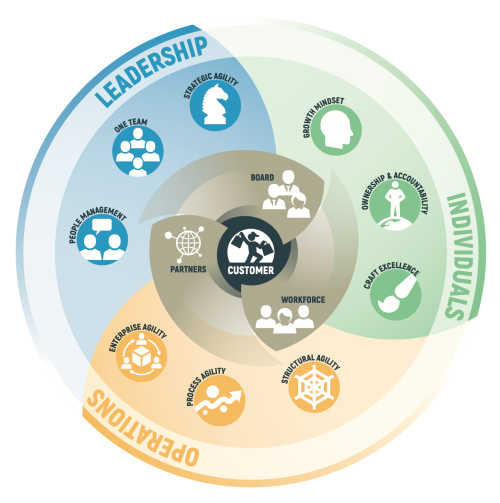 My quest continues. The Business Agility model is the next one to add to my Bird’s eye view on the agile forest.
My quest continues. The Business Agility model is the next one to add to my Bird’s eye view on the agile forest.
The Business Agility Model (developed by the Business Agility Institute) consisting of twelve interacting domains across four dimensions to take into account when transforming your organization. These are the essential building blocks for an agile organization.
At the center of the model we see the customer domain. The first ring, surrounding the customer domain is the relationship dimension with the domain’s partners, board and workforce. In the outer ring we find the three dimensions Leadership (how to shape an agile organization with domains people management, one team and strategic agility), individuals (how an agile organization delivers value with domains growth mindset, ownership & accountability and craft excellence) and operations (how an agile organization works with domains enterprise agility, process agility and structural agility). All domains are complementary and mutually necessary to business agility.
 The 12 domains explained:
The 12 domains explained:
- Customer: The heart of business agility is no less than the very reason we exist: Our customer.
- Board: Business agility requires an open, 2-way, relationship between an organization’s leaders and the board of directors; built upon customer-focus and long-term success, which enables the company leaders to go after long-term bets, as opposed to short term wins.
- Workforce: Business Agility requires a mission-aligned, passionate, empowered workforce built of individuals with a strong culture fit and potential over fit for a specific position.
- Partners: Business Agility requires partnerships crafted with flexibility and driven by customer value so both an organization and its partners are able to adapt in a coordinated and complementary manner, rather than a series of contractual transactions.
- People management: Business Agility requires leaders to recruit, hire, nurture, and develop people with a strong fit for future potential and mission alignment, over fit to position.
- One team: Business Agility requires a One Team mindset of co-creative efforts to achieve shared goals that span functions, teams, and divisions within the organization.
- Strategic Agility: Business Agility requires leaders who set, and clearly communicate, an adaptive strategy that empowers teams to identify opportunities to execute that strategy in potentially innovative and previously unforeseen ways.
- Growth mindset: Business Agility requires that individuals are open to learning by doing, continuous learning and personal development as well as being comfortable operating and making decisions in a dynamic and ambiguous environment, free from the fear of failure.
- Craft excellence: Business Agility requires craft excellence that continually improves over time, is the most impactful to creating value, and enables individuals to take advantage of emergent opportunities for customers.
- Ownership & Accountability: Business Agility requires deep ownership and accountability, so individuals close to the work and customers drive timely decision making and adaptations.
- Structural agility: Business Agility requires the ability for an organization to create coalitions or change structure as needed to embrace new opportunities with ease and without disruption.
- Process agility: Business Agility requires operations to adapt and continuously evolve as needed in service of creating value for customers.
- Enterprise agility: Enterprise Agility is a response to competitive pressure, to adapt fast to changes in market demands and seize opportunities while reducing costs. At the core of the Agile Enterprise are the People, knowledgeable, skilled and innovative.
See https://businessagility.institute/learn/domains-of-business-agility/ for more detailed information.
The business Agility model is not a framework in itself but it gives you a head start with the agile mindset and culture. Your teams can make use of Scrum, LeSS, SAFe or one of the others. In my bird’s eye view I positioned the Business Agility model in the culture-targeted box. Bird’s eye view on the agile forest article.
Bird’s eye view on the agile forest article.















